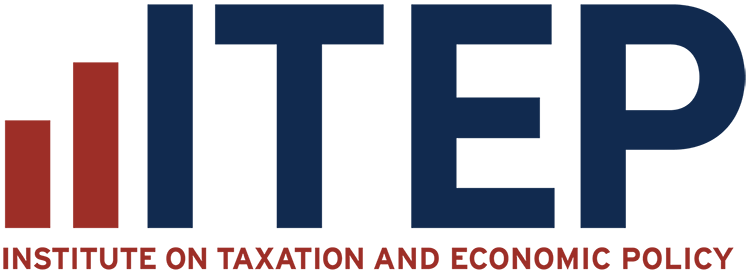
Reports
ITEP Testimony on SB 403 and SB 748 – Combined Reporting & Corporate Minimum Tax
March 9, 2005 • By ITEP Staff
My testimony today focuses on a trend in the Maryland corporate income tax that is becoming increasingly visible—the emergence of profitable “zero-tax corporations”—and on two effective and complementary solutions to this problem, mandatory combined reporting and a gross-receipts-based minimum corporate tax. Requiring combined reporting of the income of multi-state corporations would help ensure the long-term […]
Last September, Citizens for Tax Justice and the Institute on Taxation and Economic Policy published Corporate Income Taxes in the Bush Years, an in-depth look at the taxes that 275 large, profitable corporations paid, or failed to pay, on their U.S. profits over the 2001-03 period. That study found that by 2003, these corporations were […]
The Impact of the Tennessee Tax Structure Study Commission’s Tax Reform Recommendations on Tax Fairness
December 14, 2004 • By ITEP Staff
Tennessee’s tax system is regressive, requiring low- and middle-income families to pay more of their income in tax than wealthier Tennesseans. A tax reform plan recently proposed by the Tennessee Tax Structure Study Commission would reduce the state sales tax, repeal local sales taxes, cut business taxes, and introduce a personal income tax. This analysis […]
This study details which companies have benefitted the most from the decline in corporate taxes over the past three years, and which have been less fortunate. It also measures the effects of loopholes in our corporate tax laws that predated the George W. Bush administration. Specifically, the study looks at the federal income taxes paid […]
The Effects of Replacing Most Federal Taxes with a National Sales Tax
September 15, 2004 • By ITEP Staff
Recently, there has been renewed discussion of the possibility of replacing most federal taxes with a national retail sales tax. Such an idea was broached in the 1990s, but political interest waned when it was discovered that it would take a sales-tax rate well in excess of 50 percent to replace existing federal revenues. In […]
The Impact of the Ron Sims Tax Plan on Washington Tax Fairness
August 17, 2004 • By ITEP Staff
Washington’s tax system is regressive, requiring low- and middle-income families to pay far more of their income in tax than wealthier Washingtonians. A tax reform plan recently proposed by gubernatorial candidate Ron Sims would change the state’s tax system by repealing the state’s general business tax and the state sales tax, creating a $100,000 homeowner’s […]
How do personal taxes on total investment income compare to taxes on earnings right now? This paper addresses that question. The analysis includes both the individual income tax, which applies in varying degrees to both earnings and investment income, and Social Security and Medicare taxes, which apply only to wages and selfemployment earnings. The central […]
Does Personal Income Tax Progressivity Inhibit Economic Growth?
April 15, 2004 • By ITEP Staff
What is the relationship between income tax burdens and state economic growth? A December 2003 study by the Oklahoma Council of Public Affairs (OCPA), titled Income Tax Progressivity in Oklahoma: Hindering Economic Growth, Variating State Revenue, attempts to weigh in on this issue. The authors of the report claim that Oklahoma’s personal income tax is […]
The Distributional Impact of SB 1374’s Personal Income Tax Changes
March 30, 2004 • By ITEP Staff
The Missouri personal income tax currently applies a graduated rate structure with tax rates ranging from 1.5 percent to 6 percent of taxable income. This rate structure is applied to a tax base that starts with federal adjusted gross income, but allows a variety of special deductions and exemptions that allow some Missourians to reduce […]
My testimony today focuses on two revenue-raising tax bills introduced in the Maryland House of Delegates: HB 1061, the “Millionaire’s Tax Surcharge,” and HB 1306, the “Maryland Progressive Income Tax Reform Act of 2004.” In particular, my testimony will discuss the impact of each bill on the fairness of the Maryland tax system, and will […]
Tax Options for Arkansas: Funding Education After the Lake View Case
July 15, 2003 • By ITEP Staff
The purpose of this study is to analyze the implications of the Lake View case for the future of financing public education in Arkansas. The study has three broad goals: First, the report provides a detailed menu of revenue- raising options that could be used to meet the Lake View spending mandates. Second, the report […]
Simplicity is generally seen as a virtue in tax systems. The National Council of State Legislatures argues that a properly functioning tax system should “facilitate taxpayer compliance by avoiding a maze of taxes, forms and filing requirements.”1 Iowa Governor Tom Vilsack has echoed this sentiment, calling for a move to a “postcard” income tax in […]
The Impact of Imposing a “Flat Tax” on Missouri Personal Income
January 28, 2003 • By ITEP Staff
The Missouri personal income tax currently applies a graduated rate structure with tax rates ranging from 1.5 percent to 6 percent of income. This rate structure is applied to a tax base that starts with federal adjusted gross income, but allows a series of special deductions and exemptions that allow some Missourians to reduce their […]
Who Pays? A Distributional Analysis of the Tax Systems of All 50 States [2003 Edition]
January 15, 2003 • By ITEP Staff
State governments are facing a profound fiscal crisis. In the past year, states have grappled with mounting budgetary shortfalls, as tax revenues have slumped while spending pressures have continued to grow—and these problems will probably get even worse in the upcoming year. As state and local governments are forced to make hard decisions about how […]
Download the Powerpoint
NEW HAMPSHIRE: Impact of Options for Reforming New Hampshire’s Tax System (PowerPoint)
August 20, 2002 • By ITEP Staff
Download the Powerpoint
The current fiscal shortfall represents a shortterm challenge to Illinois lawmakers—but it also provides an opportunity for lawmakers to craft tax reform solutions that will ensure the longterm solvency of Illinois state and local governments. We hope this report will prove useful to both the policy makers and the citizens of Illinois as they seek […]
In April of 2001, Alabama legislators considered a pair of bills, HB 577 and HB 578, designed to modify the state’s personal income tax structure by creating a state Earned Income Tax Credit while increasing the state’s standard deduction and personal exemption. The bills also would have eliminated a deduction for federal personal income taxes […]
“Further Evidence” on the Linkage Between Income Taxes and Economic Growth?
October 13, 2000 • By ITEP Staff
Examining economic growth rates before and after a single policy change without attempting to control for other causal factors is not an exercise which should be taken seriously. The impact of tax law changes on economic growth is, rightly, a topic of great interest. But Dye’s analyses add precisely nothing to our understanding of the […]
How Would Expanding Oregon’s Deduction for Federal Income Taxes Paid Affect Elderly Oregonians?
October 5, 2000 • By ITEP Staff
Oregon is one of nine states that currently allow taxpayers to claim federal income taxes paid as a deduction on personal income tax forms. Under current law, Oregon taxpayers can deduct up to $3,000 of federal personal income tax on their Oregon tax returns. This analysis assesses the impact of two possible changes to the […]
The Commission on Virginia’s State and Local Tax Structure for the 21st Century has an opportunity to offer a vision for equitable and sensible reform. Equity, simplicity and the interaction of the state’s tax system with the federal tax system should be critical components of this vision. Read the Full Report (PDF)
The state of Louisiana is currently facing a substantial budget shortfall. Recent estimates suggest that legislators crafting the state’s fiscal year 2001 state budget must make up almost $5401 million in revenues through budget cuts or tax increases. Among the more prominent revenue-raising solutions recently under discussion have been an extension of the state’s “temporary” […]
The Institute on Taxation and Economic Policy (ITEP) has analyzed the proposed “Virginia Children’s Educational Opportunity Act 2000” (H.B. 68 and S.B. 336), to measure the effects of the bill’s proposed tuition subsidies on Virginia families with children by income group. H.B. 68 and S.B. 336 would provide Virginia parents with children in kindergarten though […]
In 1996, the Institute on Taxation and Economic Policy released a report entitled Who Pays? A Distributional Analysis of the Tax Systems in All 50 States.1 One of the findings of the study was that in 1995, Alabama had a regressive tax structure— that middle- and low-income Alabamians paid a higher share of income in […]
The Institute on Taxation and Economic Policy today released an analysis showing that states with high income tax burdens have experienced more rapid economic growth than states with low income tax burdens during the past two decades. The ITEP report, released in response to a recent Cato Institute analysis of the impact of a Tennessee […]
